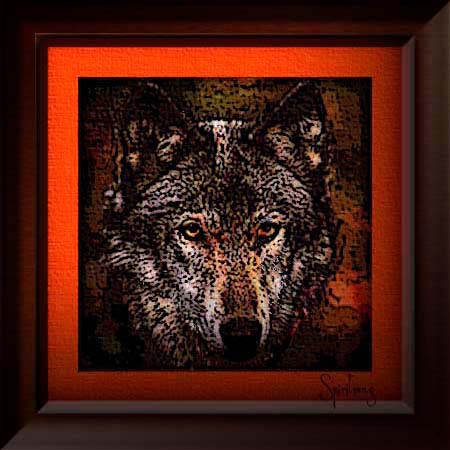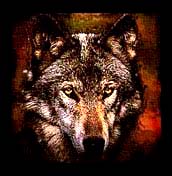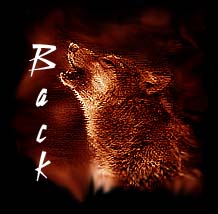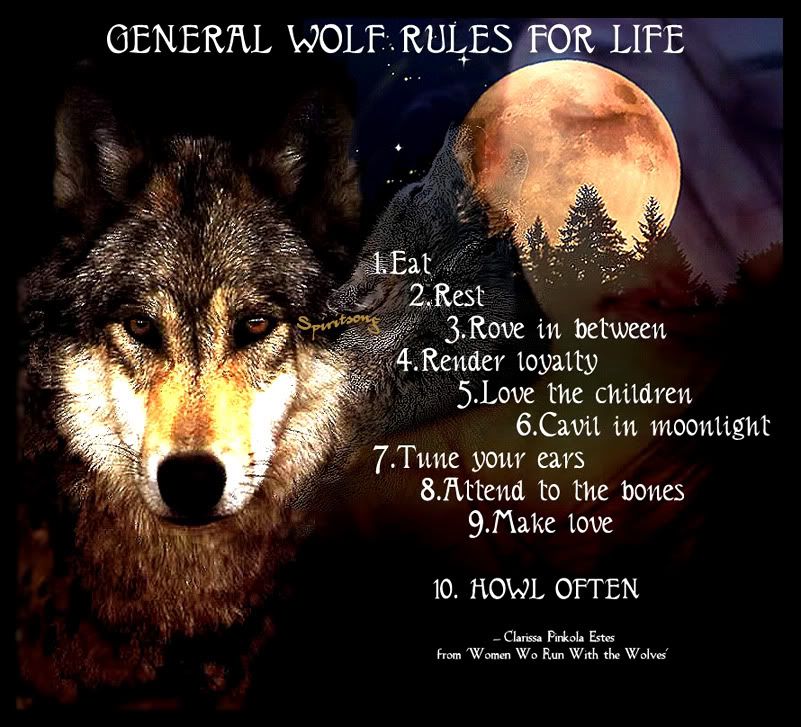|

The Strength of the Wolf
The spirit of the Wolf resides in my heart
Mostly peacefully, yet ever wild
Running in time to the blowing wind
Dancing in the clouds that drift in the Heavens.
The spirit of the Wolf resides in my soul
Longing to hear the song of the Great One
Striving to be that which I am in my natural state
Succeeding only because of the Love that the Universe grants me.
Theme from Dances with Wolves
The Wolf
There are three species of wolves in the world: the gray wolf (Canis lupus), the red wolf (Canis rufus) and the Ethiopian (or Abyssinian) wolf, (Canis simensis), though some researchers believe the Ethiopian wolf is actually a jackal and not a true wolf at all.
The gray wolf lives in the northern latitudes around the world. There are five subspecies of the gray wolf in North America and seven to 12 in Eurasia. The currently recognized subspecies in North America are:
- Canis lupus baileyi, known as the Mexican wolf or lobo.
- Canis lupus nubilus, known as the Great Plains or buffalo wolf.
- Canis lupus occidentalis, known as the Rocky Mountain wolf.
- Canis lupus lycaon, known as the eastern timber wolf.
- Canis lupus arctos, known as the arctic wolf.
Subspecies are often difficult to distinguish from one another because of interbreeding where territories overlap so that their populations tend to blend together rather than form distinctive boundaries.
Wolves usually live in packs which consist of the adult parents, referred to as the alpha pair, and their offspring. Pack size depends on largely on where they are found (Gray wolves generally have about 6 - 8 members in a pack, but in Alaska and Canada the number can be as large as 30. Red wolves usually travel in much smaller packs, generally 2 - 8)
Wolves use body language to convey the rules of the pack. To communicate dominance, the alphas carry their tails high and stand tall. Less dominant wolves hold their tails down and often lower their bodies while pawing at the higher ranking wolves.
Wolves communicate a great deal with their bodies. If they are angry, they may stick their ears straight up and bare their teeth. A wolf who is suspicious pulls its ears back and squints. Fear is often shown by flattening the ears against the head. A wolf who wants to play dances and bows playfully.
They also communicate with their voices. That familiar howl is not a wolf howling at the moon. They call at any time of the day, though they are most easily heard in the evening when the wind dies down and wolves are most active. They howl to find other pack members, to let wolves from outside of the pack know their territory boundaries, or to get the pack ready to hunt. Sometimes, it seems as if they howl just for fun. Wolves also bark to warn other pack members of danger or to challenge an enemy. They often growl in dominance disputes or other kinds of fights. They make a high whine or squeaking noise to call the pups. The pups' mother whimpers to calm the young ones.
 |
This wolf will take you to a site where you can hear various wolf vocalizations
|
The wolf appears in many legends around the world. Druidic lore depicts the wolf as the bringer of a strong sense of faithfulness, inner strength and intuition. TheTurkish speaking tribes of Central and West Asia believe that the culture's founders were mothered by a wolf. Genghis Khan also believed he was mothered by a wolf. And in Roman mythology there is the she wolf who raises the abandoned Romulus and Remus, the twin founders of Rome. This notion of a human infant being raised by a wolf mother is echoed in many other tales. A similar theme can be found in this Shoshone Legend:
The Legend of Wolf as Protector of Women
It is told that a group of young girls had to be left behind in hiding, as the tribe had to pack up and move quickly due to imminent danger.
When the girls came out of hiding and went in search of the tribe, they came upon an injured wolf. After nursing the wolf back to health, they became adopted by the entire pack of wolves, who saved them from danger many times, as the girls continued their search for the rest of their tribe.
The warrior fathers, upon returning to find the girls, saw the wolves surrounding their daughters from a distance. Not understanding that the wolves were actually protecting their daughters, they slew them one and all.
After being told of their grave mistake, they vowed to honor the wolf as protector throughout time.
This became tradition and remains so today.
But in Europe during the Middle Ages, wolves were often used as a symbol of the devil. Wolves were blamed for rabies, which was a common disease at that time and this probably helped bring about the demise of the wolf in Britain & many parts of Europe.
To most Native Americans, however, the wolf is a powerful spiritual symbol. They are considered to be teachers or pathfinders. The red star, Sirius, is the brightest star in the Northern Sky and is known as the Wolf Star. The milky way was the wolf's trail - the route to heaven. The wolf appears in many legends as a messenger and a guide for anyone seeking the spirit world. He was the forerunner of new ideas who returned to the clan to teach and share medicine.

Wolves are intrinsically shy and peace loving creatures. There has
never been a documented case of a healthy wolf killing a human in North America.
On the other hand, while a healthy population of as many as 750,000 wolves once roamed the contiguous United States, this number was reduced by 99.8 percent to about 450 animals in the late 1960s because of their perceived threat to livestock. Thanks to the efforts of Conservation groups, and a growing wave of public support for proper management and selective reintroduction of the wolf, their population is again growing, though slowly and in only a handful of states. (This link will take you to a map showing the current location of wolf populations in North America). Even so, the continued protection of the wolf hinges on each new Administration's Environmental policies, and at any time their fate can change. The following groups are and have been instrumental in protecting the wolf . Please visit their sites to learn more about their efforts and to show your support.
Defenders of Wildlife
The National Wildlife Federation
North American Wolf Association
The Wolf Society of Great Britain
The Wolf Portal
Wolf Haven International
Defend The Wolves Rescue Site
Kerwood Wolf Education Centre Inc
U.S. Fish & Wildlife Mexican Wolf Recovery Program
U.S. Fish & Wildlife Gray Wolf Recovery Program
Wolf Education & Research Center
Save the Toklat Wolf


|